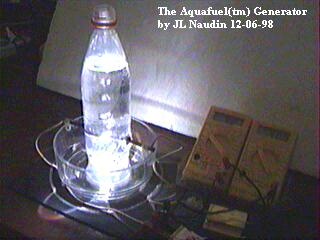

The AquaFuel� generator
How to generate gas from water for use as Fuel
created on 12-06-98 - JLN Labs - last update on 02-06-2001
All informations in this page are published free and are intended for private/educational purposes and not for commercial applications Disclaimer: The author assumes no liability for any incidental, consequential or other liability from the use of this information. All risks and damages, incidental or otherwise, arising from the use or misuse of the information contained herein are entirely the responsibility of the user. Although careful precaution has been taken in the preparation of this material. |
The Aquafuel� is a trademark from Aqualux Corporation
"AquaLux produces the new patented gas, AquaFuel�. AquaFuel is a non-fossil alternative fuel that is a clean synthetic gas with unusual properties. AquaFuel is the only known fuel that emits oxygen when it burns. AquaFuel is one of only three gases that are lighter than air. (Hydrogen and helium are the other two.) "
Today ( on 12-06-98 ), I have built and
reproduced successfully a very simple AquaFuel™ generator:
"The AquaFuelTM is a
nonfossil combustible gas discovered by Mr. Bill Richardson,
which is produced by an electric discharge of carbon arcs within
distilled, fresh, salt or other types of water, thus being
essentially composed of Hydrogen, Oxygen, Carbon and their
compounds". This technology has already been patented (US#5,159,900
and US#5,417,817
and US#5,435,274).
This generator produces a mixture of carbon monoxide and hydrogen (COH2) and this is a gas wich burns very cleanly in oxygen or air, and it can be used as fuel for an internal combustion engine. When burned, COH2 produces carbon dioxide and water vapor, so it generates very little, if any, pollution to the environnement.
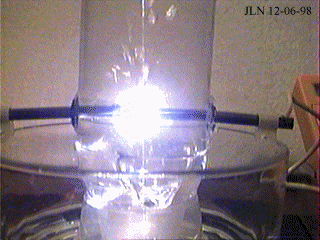
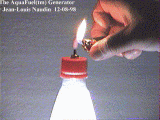
This simple experiment is only for testing purposes and only for a proof of the concept. This small generator can't be used for a long working period and it must be used only for demonstration.
You need to get very few materials and it is very simple to build and test it....
Be Carefull, this device generates an explosive gas, you must conduct this test in a well ventiled room or better in open air, you must not smoke during the test.. Don't forget that the carbon monoxide ( CO ) is a very toxic gas, so never breath this gas before burning it. This experiment is not intended for the inexperienced. User of this document should be very carefull to try anything out ! If you do it the risk of any results is just yours. I take no responsibility of anything that might happen, let it be of a wrong information or anything else.
You need only to get :
- A little plastic soda bottle,
- two carbon rods ( 70mm length, 6mm diam )
- one 1 ohm 50Watts resistor
- a DC Power supply which is able to deliver 35v / 10A
- some wires, plugs and silicon cement.
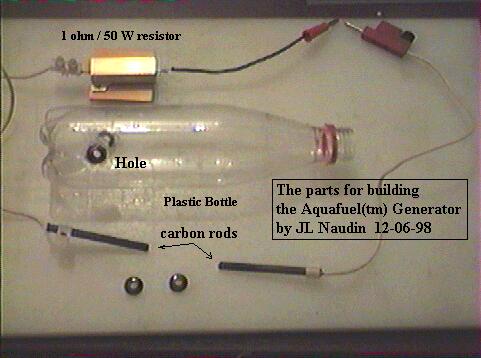
Very few material is needed.....
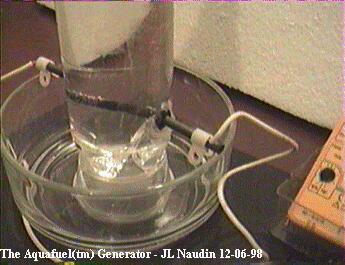
1) Drill two opposite holes (10mm diam) at 60mm from the bottom of the bottle and insert the carbon rods with a rubber washer and glue the washer with silicon cement. I suggest you to make one of the carbon rod into round shape. The two carbon rods must be just slightly in contact before you switch on (see below).

2) Connect the 1 ohm 50W resistor in serie with one of carbon rod and one pole of your DC power supply ( set for 34V/15A DC), the other pole of your power supply is connected to the other carbone rod. You may add some additional multimeters for measuring the Current and the Voltage input. Fill up your generator with only distilled or fresh water.
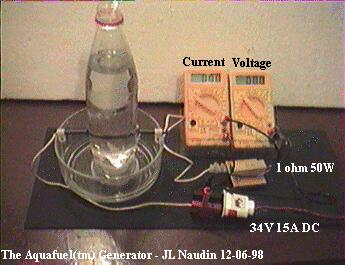
3) Now, your are ready to produce AquaFuel(tm)......
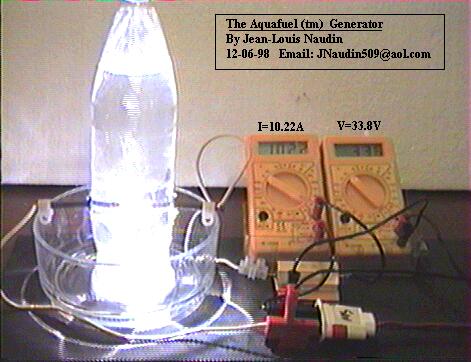

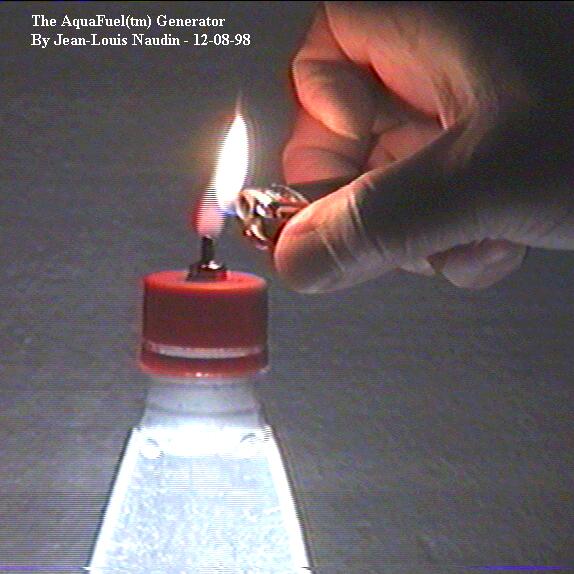
Click here to see some animated videos of the AquaFuel(tm) generator in action
You will see below some videos which show my AquaFuel(tm) in action and some personal comments.......
click here to see the AquaFuel(tm) demo 1 (277kb)
click here to see the AquaFuel(tm) demo 2 (90kb)
( if you don't have the RealPlayer 5.0, you may download it freely at : http://www.real.com/products/player/ )
Some reference documents and web link :
The Aquafuel� is a trademark from Aqualux Corporation
![]() Email
: [email protected]
Email
: [email protected]
Return to the JLN Labs home page